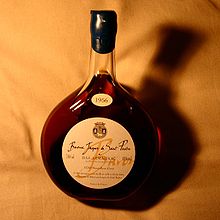Armagnac
This article needs additional citations for verification. (March 2008) |

Armagnac (French pronunciation: [aʁmaˈɲak]) is a distinctive kind of brandy or eau de vie produced in the Armagnac region in Gascony, southwest France. It is distilled from wine usually made from a blend of grapes including Ugni Blanc, Colombard, and Baco 22A, using column stills rather than the pot stills used in the production of Cognac. The resulting spirit is then aged in oak barrels before release. Production is overseen by INAO and the Bureau National Interprofessionel de l'Armagnac - [1] (BNIA).
Armagnac was one of the first areas in France to begin distilling spirits, but the brandies produced have a lower profile than those from Cognac and the overall volume of production is far smaller. In addition they are for the most part made and sold by small producers, whereas in Cognac production is dominated by big-name brands.[1]
Geography
The Armagnac region lies between the Adour and Garonne rivers in the foothills of the Pyrenees. The region was granted AOC status in 1936. The official production area is divided into three districts that lie in the departements of Gers, Landes, and Lot-et-Garonne. The May 25, 1909 Falliere’s decree describes the three districts:
Each of these areas is controlled by separate appellation regulations. More recently, a new appellation—"Blanche d'Armagnac"—was established to allow the production and export of clear, white brandies that are unaged.[2]
Production
The region contains 40,000 acres (160 km²) of grape-producing vines.[citation needed]
Armagnac is traditionally distilled once, which results initially in a less polished spirit than Cognac, where double distillation usually takes place. However, long aging in oak barrels softens the taste and causes the development of more complex flavours and a brown colour. Aging in the barrel removes a part of the alcohol and water by evaporation (known as part des anges—"angel's tribute" or "angel's share") and allows more complex aromatic compounds to appear by oxidation, which further improves the flavour. When the alcohol reaches 40%, the Armagnac can be transferred to large glass bottles (called "Dame Jeanne") for storage. From then on, the Armagnac does not age or develop further and can be bottled for sale from the next year on.
Armagnac is sold under several different classifications, mostly referring to the age of the constituent brandies. When brandies of different ages have been blended, the age on the bottle refers to the youngest component. A three star, or "VS," Armagnac is a mix of several Armagnacs that have seen at least two years of aging in wood. For the VSOP, the aging is at least five years; and for XO, at least six. Hors d'âge means the youngest component in the blend is at least ten years old. Older and better Armagnacs are often sold as vintages, with the bottles containing Armagnac from a single year, the year being noted on the bottle.
As with any "eau de vie," Armagnac should be stored vertically to avoid damaging the stopper with alcohol. Once opened, a bottle should stay drinkable for years.
Grapes
Ten different varieties of grape are authorised for use in the production of Armagnac. Of these, four form the principal part:
The main brands and the houses of Armagnac are :
- Domaine Boingnères ( Le Frêche )
- La Martiniquaise
- Armadis (marques: Sempé, Clés des Ducs, Chabot, Cavé)
- Château de Lacquy
- Cave des producteurs réunis
- Janneau
- Larressingle
- Laubade
- Samalens
- Compagnie générale de Guyenne
- Delord
- Darroze
- Gélas
- Marquis de Montesquiou
- Le Domaine d'Esperance
- Marcel Trépout (Marques & Domaines de Gascogne)
- Armagnac Baron de Sigognac
- Château du Busca-Maniban
- Chateau Laballe
- Château de Ravignan
- Château Arton (Haut Armagnac)
- Dartigalongue
- Domaine de Joÿ
- Claverie
Armagnac can also be added to other ingredients to produce liquors that are sold as another drink - the Austrian company Vom Fass produces fruit liquors with Armagnac (they are about 16% alcohol).
History
Armagnac is the oldest brandy distilled in France, and in the past was consumed for its therapeutic benefits. In the 14th century, Prior Vital Du Four, a Cardinal, claimed it had 40 virtues.
"It makes disappear redness and burning of the eyes, and stops them from tearing; it cures hepatitis, sober consumption adhering. It cures gout, cankers, and fistula by ingestion; restores the paralysed member by massage; and heals wounds of the skin by application. It enlivens the spirit, partaken in moderation, recalls the past to memory, renders men joyous, preserves youth and retards senility. And when retained in the mouth, it loosens the tongue and emboldens the wit, if someone timid from time to time himself permits."
Between the 15th and 17th centuries, Armagnac was traded on the markets of Saint-Sever, Mont-de-Marsan, and Aire-sur-Adour. Subsequently, Dutch merchants began promoting the trade more widely.
Health benefits
Research conducted by scientists at Bordeaux University in 2007 suggested that Armagnac has health benefits,[3] finding that moderate consumption can help protect against heart disease and obesity. The research seemed to indicate that the benefits derived from its unique distillation process and aging rather than from its alcoholic content. The southwestern area of France, where Armagnac is produced, has some of the lowest cardiovascular disease rates in the world. [citation needed]
External links
- BNIA Armagnac official website
- History of Armagnac
- Domaine Boingnères - Folle Blanche ,Colombard and Ugni Blanc
- Château de Lacquy, Armagnac producer and distributors list
- Armagnac in the kitchen
